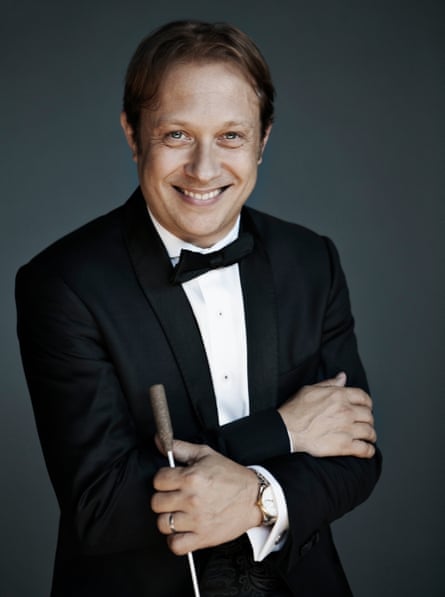Morlot steps in to skillfully handle a challenging Utah Symphony program

Conductor Ludovic Morlot showed consummate skill, musicality, and versatility at the helm of the Utah Symphony Friday night at Abravanel Hall.
Filling in for music director Thierry Fischer, who cancelled due to an injury this week, Morlot acquitted himself brilliantly on the difficult and eclectic program Fischer had planned.
The program included Tchaikovsky’s Piano Concerto No. 1 with Russian pianist Andrei Korobeinikov, making his North American debut. Morlot, who is currently director of the Barcelona Symphony Orchestra and conductor emeritus of the Seattle Symphony, made his Utah Symphony debut last season, also substituting when Fischer was out with Covid.
The Tchaikovsky was the only piece on the program that could be called “standard repertoire.” The program also included Augusta Read Thomas’s Dance Foldings and iconoclastic American composer Charles Ives’ Symphony No. 2.
The concert began with the charming Sinfonia from Antonio Salieri’s comic opera Prima la musica poi le parole (“First the music, then the words”), which tells the story of backstage life at an opera house. Thanks to the play and film Amadeus, Salieri is primarily known as Mozart’s less talented rival, but he was a skilled and influential composer with a unique voice.
The Sinfonia has an infectious melody, elegant structure, and chromatic lines that foreshadow Rossini. With clear, conscientious phrasing and crisp articulation, the performance bustled with comic energy while staying true to its innate Classical style.
Pianist Korobeinikov took the stage dressed casually, in black slacks and an untucked dark gray shirt. His interpretation of the Tchaikovsky was also casual, in that it was stripped of the affectation and sentimentality that sometimes accompany this warhorse of warhorses.
Instead, Korobeinikov focused on the piece’s thematic development, clearly presenting each melodic idea. While his flawless technique gave him full command of the piano’s dynamic range and he skillfully executed the first movement’s cascading chords, octave runs, and ostinato passages, his overall interpretation was a bit dry.
It was in the second movement that Korobeinikov and the orchestra showcased their musicality. Principal Flute Mercedes Smith stated the main theme with musicality and grace, and Korobeinikov picked up on her expression. He used very little damper pedal, relying instead on articulation and phrasing to give the opening melody color. In the scherzo-like middle section, the soloist was impressively light, and he used a full pallet of color.
Although there were moments where the orchestra and Korobeinikov were out of sync rhythmically, they were on the same page with regard to the piece’s phrasing, dynamics, and overall structure. This was particularly true in the third movement’s thrilling rise to the climax, which Korobeinikov finished with aplomb.
As an encore, he played “August” from Tchaikovsky’s The Seasons which showcased his ability to communicate a gentle melody simply and subtly, without sentimentalizing.
Perhaps a little afraid of the concert’s more “modern” second half, much of the audience left during intermission.
They had little to fear. Thomas’s Dance Foldings, which premiered last year at London’s Proms concerts, had an engaging rhythmic vitality; and although Ives’ later work could be quite dissonant, his Symphony No. 2 is like Samuel Barber with some adventurous harmonic and contrapuntal flourishes. Thanks to Morlot, those who stayed were treated to an hour of first-rate music-making and one of the highlights of the season so far.
In a brief speech introducing her piece, Thomas asked the audience to think of her piece like one of Alexander Calder’s mobiles, with different parts swirling at different speed and some of those parts including prisms. Indeed, motion—driven by pizzicato strings, congas, and marimba—was the most salient feature of her piece.
Thomas’s voice is unique, but one way to describe Dance Foldings would be Pierre Boulez meets Prokofiev. The thematic material developed in loops that at first seemed mechanical but were soon revealed to be part of a grand, expressive design, which the orchestra played with sensitivity, precision, and vitality. After such a thrilling performance of an engaging contemporary work, the audience’s tepid response was disappointing.
They warmed more to Ives’ five-movement work, the spirit of which came through in Morlot’s loving interpretation. Foreshadowing the more dissonant juxtapositions in his later work, Ives’ Symphony No. 2 features thinly disguised American folk melodies, such as “America the Beautiful,” “Columbia Gem of the Ocean,” and “Camp Town Races” in two-part melodies in the late Romantic, European classical tradition.
The orchestra achieved a rich, full, warm sound in the strings and an exquisite blend. In sculpting the phrases, Morlot occasionally used just his right hand with no baton, and the orchestra’s swells were infused with apt longing. Cellist Silver Ainomae, auditioning as a finalist for principal cello, took a prominent role with a sweetly phrased solo passage that turned into a cello duet in the elegiac third movement. He shone again in an expressive contrapuntal duet with Smith on flute in the fourth movement, which set the stage for the spirited finale.
The program will be repeated 7:30 p.m. utahsymphony.org